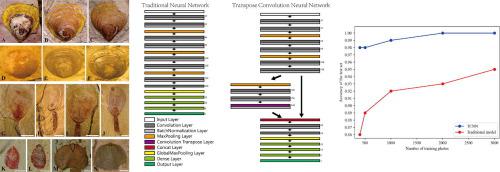Gondwana Research ( IF 7.2 ) Pub Date : 2021-09-22 , DOI: 10.1016/j.gr.2021.09.011 Haizhou Wang 1, 2 , Chufan Li 3 , Zhifei Zhang 4 , Stephen Kershaw 5 , Lars E. Holmer 4, 6 , Yang Zhang 1, 2 , Keyi Wei 1, 2 , Peng Liu 7

|
The identification of brachiopods requires specialist knowledge held by a limited number of researchers and is very time-consuming. The new technique of deep learning by artificial intelligence offers promising tools to break these shackles to develop computer automatic identification. However, we found that the traditional convolution neural network is not sufficient to automatically identify brachiopod species. Thus, we propose a new tailored Transpose Convolutional Neural Network (TCNN) in order to automatically identify brachiopod fossils with high efficiency. In this network, we add an “upsampling” Transpose Convolutional Layer and synthesize the data of this layer with the data of a Convolutional Layer to fully mix the small and large scales features extracted by the neural network. Compared with the traditional Convolution Neural Network (CNN), the Transpose Convolutional Neural Network (TCNN) can achieve a high identification accuracy using a smaller training data set of images of brachiopods. Results from this study show that the TCNN can achieve 98%, 98% and 97% identification accuracy respectively, with training data sets of 400 images of 3 species, 484 images of 4 species and 630 images of 5 species. In contrast, the traditional CNN can achieve only a low identification accuracy (67%) with 400 images of 3 species and requires 3000 images per 3 species to achieve a 95% identification accuracy. For most of brachiopod species, it is almost an impossible task to collected thousands of samples and as more brachiopod species are fitted into automatic identification, it is significant to have a reliable network which can achieve high accuracy on a small data set. In summary, the TCNN is a more efficient neural network that could be better applied to automatically identify brachiopod fossils.
中文翻译:

使用新的深度卷积神经网络识别腕足动物化石
腕足动物的鉴定需要少数研究人员掌握的专业知识,而且非常耗时。人工智能深度学习的新技术为打破这些束缚以开发计算机自动识别提供了有前途的工具。然而,我们发现传统的卷积神经网络不足以自动识别腕足动物物种。因此,我们提出了一种新的定制转置卷积神经网络(TCNN),以便高效地自动识别腕足动物化石。在这个网络中,我们添加了一个“上采样”转置卷积层,并将该层的数据与卷积层的数据进行合成,以充分混合神经网络提取的小尺度和大尺度特征。与传统的卷积神经网络 (CNN) 相比,转置卷积神经网络 (TCNN) 可以使用较小的腕足动物图像训练数据集实现较高的识别精度。本研究结果表明,TCNN的识别准确率分别为98%、98%和97%,训练数据集为3种400张图像、4种484张图像和5种630张图像。相比之下,传统的 CNN 在 3 个物种的 400 张图像中只能达到较低的识别准确率(67%),并且需要每 3 个物种 3000 张图像才能达到 95% 的识别准确率。对于大多数腕足动物物种来说,收集数千个样本几乎是一项不可能完成的任务,并且随着越来越多的腕足动物物种被纳入自动识别,拥有一个可以在小数据集上实现高精度的可靠网络非常重要。总之,TCNN 是一种更高效的神经网络,可以更好地应用于自动识别腕足动物化石。











































 京公网安备 11010802027423号
京公网安备 11010802027423号